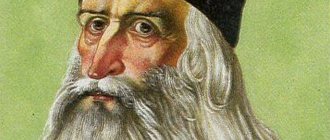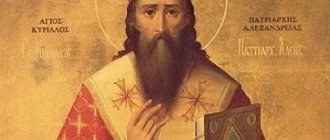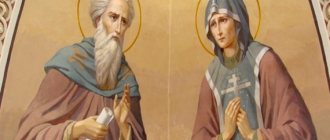The worldly life of future saints
Two brothers were born in the city of Thessaloniki. Their father is a soldier under the governor of the city. The years of life of Cyril and Methodius in a brief biography refer to the 14th century AD.
The elder brother Methodius was born in 815, Cyril, born Constantine, was born in 827. Methodius, at the birth of Michael, was initially even appointed to the princely place. But the bustle of the world tired the young man. He refused this privilege and took monastic vows at the age of 37.
The younger brother Kirill consciously chose a spiritual path for himself from the very beginning. Thanks to his curiosity and phenomenal memory, he won the favor of those around him. Cyril was sent to Byzantium, where he studied with the emperor himself. Having thoroughly studied geometry, dialectics, arithmetic, astronomy, rhetoric and philosophy, he became interested in studying languages. His noble origin allowed him to enter into an advantageous marriage and obtain a high government position. But the young man decided to build his life differently. He got a job at the Hagia Sophia as a library curator, and later became a teacher at the university. He often took part in philosophical debates. For his excellent oratory and erudition, they began to call him the Philosopher. But worldly life is just part of the short biography of Cyril and Methodius, which quickly ended. A new story has begun.
The beginning of the spiritual path
Court life did not suit Cyril, and he went to his brother’s monastery. But he never found the spiritual silence and solitude that he so longed for. Kirill was a frequent participant in disputes concerning issues of faith. He knew the canons of Christianity very well and often defeated his opponents thanks to his intelligence and high knowledge.
Later, the Byzantine emperor expressed a desire to win over the Khazars to the side of Christianity. Jews and Muslims have already begun to spread their religion on their territory. Cyril and Methodius were sent to enlighten the Khazar minds with Christian sermons. Their biography tells of an interesting incident. On the way home, the brothers visited the city of Korsun. There they were able to obtain the relics of St. Clement, the former Pope. After returning home, Cyril stayed in the capital, and Methodius went to the Polychrome monastery, which was located near Mount Olympus, where he received the abbess.
Mission to Moravia
The biography of the brothers Cyril and Methodius is based on chronicle data. According to them, in 860, ambassadors from Prince Rostislav of Moravia approached the Byzantine emperor with a request to send preachers to praise Christianity. The emperor, without hesitation, entrusted an important task to Cyril and Methodius. Their biography tells of the difficulty of completing the assignment. It consisted in the fact that German bishops had already begun their activities in Moravia, aggressively opposed to the activities of anyone else.
Arriving in Moravia, Cyril discovered that almost no one knew the Holy Scriptures, since the service was performed in a language unknown to the people - Latin. Preachers from Germany were of the opinion that services could only be conducted in Latin, Greek and Hebrew, because it was in these languages that the inscriptions on the cross where Christ was crucified were written. The Eastern clergy accepted holding services in any language.
The main task of the future saints was to create their own alphabet. After writing their alphabet, they began to rewrite the scriptures into a language understandable to the people. But in order to conduct divine services, it was necessary not only to create your own letter, but also to teach the people to read and write.
The Moravian clergy were wary of such innovations, and later began to oppose them. An important factor was not only spiritual life, but also political life. Moravia was actually subject to the jurisdiction of the Pope, and the spread of a new script and language there was looked upon as an attempt to seize power by the Byzantine emperor at the hands of preachers. At that time, Catholicism and Orthodoxy were still a single faith under the patronage of the Pope.
The active work of Cyril and Methodius aroused the indignation of the German bishops. Since Cyril always won in religious disputes, German preachers wrote a complaint to Rome. To resolve this issue, Pope Nicholas I called on the brothers to come to him. Cyril and Methodius were forced to go on a long journey.
When did the modern Russian alphabet appear?
The first reform was carried out in 1917-1918. Its goal was to improve the spelling of the Slavic language. At the same time, changes were even made to the books. The changes that the Russian alphabet underwent led to the emergence of the modern alphabet.
At the same time, the Russian language is fraught with the following secrets:
- In the modern Russian alphabet there is the letter “ё”. However, not everyone knows that it was introduced by the Academy of Sciences in 1783. This was done by Princess Vorontsova-Dashkova, who at that time was its head. She asked the academicians why the word “iolka” uses 2 letters to convey the first syllable. After the princess did not receive a suitable answer, she issued an order to introduce a new letter for use in writing.
- The authors of the Russian alphabet did not leave explanations for the silent letter “er”. It was used until 1918 and came after hard consonants. Moreover, writing this letter cost the treasury more than 400 thousand rubles.
- A rather complex letter of the Russian alphabet is considered to be “i” or “i”. The reforming philologists were unable to decide which sign should be left. The evidence for the importance of their use seemed quite substantial. At the same time, these letters were read the same. The only differences were the semantic loads. For example, “peace” meant “universe,” and “peace” meant “absence of war.” After decades of discussions, the creators of the alphabet left the letter “i”.
- The letter "e" used to be called "e reverse". Lomonosov did not recognize it for a long time, because he considered it borrowed. However, as a result, the letter found its use in the Russian language.
Creation of the alphabet
The full biography of Cyril and Methodius is filled with references to the origin of their greatest creation. Kirill knew the Slavic language well and therefore began to create an alphabet for the Slavs. His older brother actively helped him. The first alphabet was modeled after the Greek alphabet. The letters corresponded to the Greek ones, but had a different appearance, and Hebrew letters were taken for the characteristic Slavic sounds. This version of the alphabet was called the Glagolitic alphabet, from the word “verb” - to speak. Another version of the alphabet is called the Cyrillic alphabet.
The Glagolitic alphabet is a set of sticks and symbols that echo the Greek alphabet. Cyrillic is already a variant closer to the modern alphabet. It is generally believed that it was created by the followers of saints. But debate about the truth of this statement is still ongoing.
It is difficult to accurately establish the date of formation of the alphabet, since the original source has not reached us; there are only secondary or rewritten letters.
Three parts
The Old Church Slavonic alphabet can be divided into three parts: “higher”, “lower” and “divine”. The first of them, by the names of the initial letters, carries a certain semantic message; the second is the opposite: the names of these letters are syllables, often unpleasant to the ear; the third part of the alphabet - the divine symbols located in the middle of the alphabet - is the most mysterious of secrets.
Metamorphoses of the first alphabet
As soon as Cyril and Methodius completed their work on the creation of Slavic writing, they began to translate a number of books for worship. Many students and followers helped them in this. This is how the Slavic literary language appeared. Some words from it have survived to this day in the Bulgarian, Ukrainian and Russian languages. The early version became the basis of the alphabet of all Eastern Slavs, but the later version was not forgotten either. It is now used in church books.
Initially, Cyrillic letters were written separately from each other and were called ustav (statutory letter), which over time transformed into semi-ustav. When the original letters were modified, cursive writing replaced half-character. Since the 18th century, during the reign of Peter I, some letters were excluded from the Cyrillic alphabet and called the Russian civil alphabet.
Runic letter
Slavic runes appeared even before the creation of writing. They were intended to inform people. There were a total of 18 runes, which complemented various ceramics, articles and other artifacts.
As an example, we can cite products from Lepesovka, a village in southern Volyn. A clay vessel was also found in Voyskovo. In addition to the evidence that was found in Russia, there are monuments in Poland. They were found in 1771. There are also images of Slavic runes.
Cyril and Methodius in Rome
After troubles with the German bishops, Cyril and Methodius were summoned to trial before the Pope. Going to the meeting, the brothers took with them the relics of St. Clement, previously brought from Korsun. But an unforeseen circumstance happened: Nicholas I died before the arrival of the future saints. They were met by his successor Adrian II. An entire delegation was sent out of town to meet the brothers and the holy relics. As a result, the Pope gave his consent to conduct services in the Slavic language
During the trip, Kirill weakened and felt unwell. He fell ill from illness and, foreseeing his imminent death, asked his older brother to continue their common cause. He adopted the schema, changing the worldly name of Constantine to the spiritual name of Cyril. His older brother had to return from Rome alone.
Methodius without Cyril
As promised, Methodius continued his activities. Pope Adrian II proclaimed Methodius a bishop. He was allowed to conduct services in the Slavic language, but on the condition that he must begin the service in Latin or Greek.
Upon returning home, Methodius took several students and began to translate the Old Testament into the Slavic language. He opened church schools and enlightened young, immature minds in matters of Orthodoxy. The population increasingly abandoned the parishes, where services were conducted in Latin, and went over to Methodius’s side. This period is one of the brightest episodes in the biography of Cyril and Methodius.
World order code
The connection between numbers and letters had its own interpretations, so in the Middle Ages they calculated the meaning of a word by adding up the numerical values of the letters in order to discover a new meaning in them. For example, the number of Christ is considered to be 888, which is the sum of the numbers and letters of the name Jesus in Greek. Therefore, those who turn to the Old Church Slavonic alphabet struggle with the mystery of the numerical designation of its letters, looking for the code of the entire world order in the ancient alphabet: from the creation of the world to the Last Judgment.
The sad fate of the followers
With the gradual growth of the authority of the German feudal lords and the change of power in the lands of Moravia, mass persecution of Methodius and his followers began. In 870 he was detained for “uncontrolled arbitrariness.” His associates are also arrested along with him.
They were in captivity for six months until they were brought to trial. As a result of lengthy disputes, Methodius was defrocked and imprisoned in a monastery. Only once he got to Rome was he able to refute the empty accusations and regain the rank of archbishop. He continued his educational activities until his death in 885.
After his death, a ban was immediately issued on holding services in the Slavic language. His students and followers faced death or slavery.
Despite all the difficulties, the brothers' life's work flourished with greater vigor. Thanks to them, many peoples acquired their written language. And for all the trials that the brothers had to endure, they were canonized - canonized. We know them as Equal-to-the-Apostles Cyril and Methodius. Everyone should know and honor the biography of Saints Cyril and Methodius as a tribute to their work.
Glagolitic in Rus'
In Rus', Slavic writing immediately appeared in the form of the Cyrillic alphabet. Therefore, the Glagolitic alphabet was not widespread here. Not a single East Slavic manuscript or birch bark letter that was written in the Glagolitic alphabet has survived to this day. However, there is still some evidence of the use of the Glagolitic alphabet. For example, graffiti depicting Glagolitic symbols have been preserved in Kyiv and Novgorod. They date from the eleventh to twelfth centuries.
In addition, some Glagolitic symbols and words are found in a number of medieval Slavic manuscripts. They date from the eleventh to twelfth centuries. It is worth noting that most examples of the use of the Glagolitic alphabet were found in the Novgorod-Pskov region.
For centuries, mastery of this type of literacy was very important for every Russian book writer. In their records, the Glagolitic alphabet sometimes served as secret writing. Moreover, it was used not to hide information, but for a kind of intellectual game with readers. Sometimes Ivan Blinov, a famous book writer who lived in the nineteenth and twentieth centuries, used the Glagolitic alphabet in his notes.









